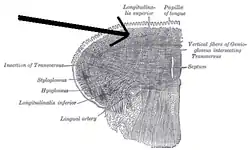Superior longitudinal muscle of tongue
The superior longitudinal muscle of tongue or superior lingualis is a thin layer of oblique and longitudinal fibers immediately underlying the mucous membrane on the dorsum of the tongue.
| Superior longitudinal muscle of tongue | |
|---|---|
 A coronal section of tongue, showing intrinsic muscles. | |
| Details | |
| Origin | close to epiglottis, from median fibrous septum |
| Insertion | edges of tongue |
| Nerve | hypoglossal nerve (CN XII) |
| Actions | retracts tongue with inferior longitudinal muscle, making tongue short and thick |
| Identifiers | |
| Latin | musculus longitudinalis superior linguae |
| TA98 | A05.1.04.106 |
| TA2 | 2122 |
| FMA | 46693 |
| Anatomical terms of muscle | |
Structure
The superior longitudinal muscle of the tongue is one of the intrinsic muscles of the tongue.[1] It arises from the submucous fibrous layer close to the epiglottis and from the median fibrous septum, and runs forward to the edges of the tongue.
Nerve supply
The superior longitudinal muscle of the tongue is supplied by the hypoglossal nerve (CN XII).[2]
Function
The superior longitudinal muscle of the tongue works with the other intrinsic muscles to move the tongue.[1]
References
![]() This article incorporates text in the public domain from page 1130 of the 20th edition of Gray's Anatomy (1918)
This article incorporates text in the public domain from page 1130 of the 20th edition of Gray's Anatomy (1918)
- Aggarwal, Annu; Thompson, Philip D. (2011). "44 - Unusual focal dyskinesias". Handbook of Clinical Neurology. Elsevier. pp. 617–628. doi:10.1016/B978-0-444-52014-2.00044-6. ISBN 978-0-444-52014-2. ISSN 0072-9752.
- Love, Russell J.; Webb, Wanda G. (1992). "7 - The Cranial Nerves". Neurology for the Speech-Language Pathologist (2nd ed.). Butterworth-Heinemann. pp. 112–136. doi:10.1016/B978-0-7506-9076-8.50013-7. ISBN 978-0-7506-9076-8.
This article is issued from Wikipedia. The text is licensed under Creative Commons - Attribution - Sharealike. Additional terms may apply for the media files.